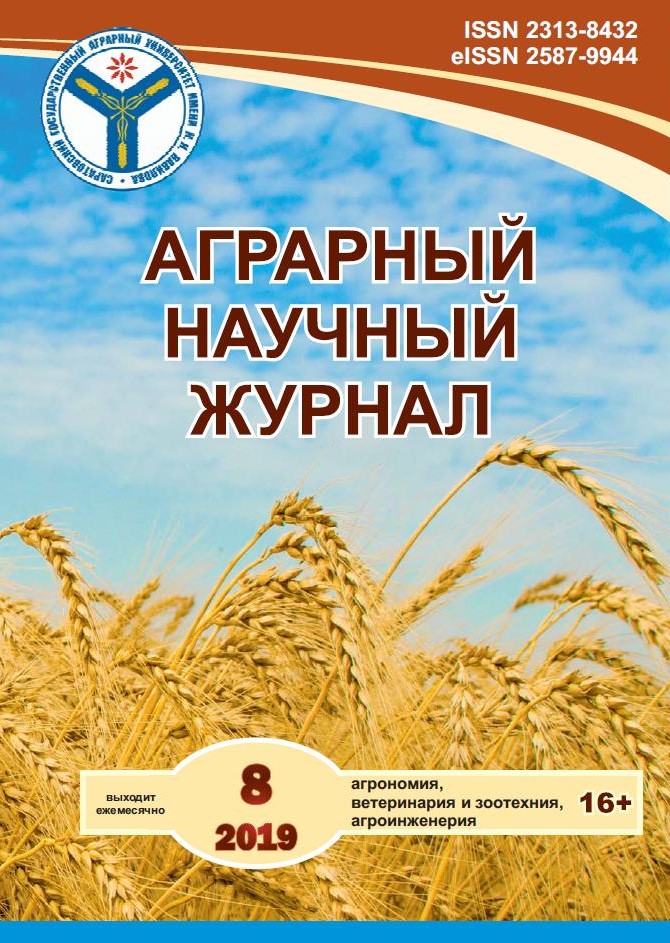The influence of crops on the agrochemical properties of alluvial soils of the central floodplain of the Moksha River
DOI:
https://doi.org/10.28983/asj.y2019i8pp17-23Keywords:
alluvial soils, perennial grasses, potatoes, agrochemical properties, humus, acidity, hydrolytic acidity, the amount of metabolic bases, base saturation, phosphorus, potassiumAbstract
Studies have shown that long-term cultivation of agricultural crops is influenced the agrochemical properties of alluvial soils. The perennial herbs affect the content of humus in the soil. In the sod layer under them is being 6,4–6,8 % of organic matter, in the subsurface – 5,3–5,9 %. Down the profile is reduced to 2.2–3.8 %. With long-term cultivation of potatoes, which after itself contains a little amount of root residues, the processes of decomposition of organic substances in the soil prevail over the processes of their synthesis. depends on Accordingly the content of humus is much lower (0.5–4.6 %). Alluvial soils under crops of the perennial herbs were characterized by neutral and slightly acidic active reaction of soil solution (pH of water extract is 6.5–7.5, pH of salt extract is 5.5–6.8). Under potatoes, the pH of the aqueous extract is reduced to 5,9–6,9, salt to 5,4–6,7, which is probably due to an increase in the pH of the upper horizons as a result of mineral fertilizers. Hydrolytic acidity of floodplain soils is rather low in all variants (1,1–2,7 mg/100 g of soil), it is characterized as neutral. The index of the sum of the exchange bases to a greater extent depends on the particle size distribution. Accordingly, it is high both under the perennial herbs and under potatoes. The studied alluvial soils are almost completely filled with bases. The value of this indicator is quite high: 91-97 %. Moreover, under the perennial herbs the index is 1-3 % in arable and 1-4 % in sub-arable horizons higher than under potatoes. The soils of the floodplain of The Moksha river are low in phosphorus and potassium in all variants of the experiment. Just above these figures were under the potatoes due to greater cultivation. With an increase in the level of agricultural technology, saturation of crop turnover with perennial grasses, a justified system of fertilization, the agrochemical properties of alluvial soils of the Central floodplain of The Moksha river are favorable for the stable harvest yields of vegetable and field crops.
Downloads
References
2. Ахтырцев Б.П., Щетинина А.С. Почвы пойм и их использование. – Саранск: Мордов. кн. изд. Управления по делам издательств, полиграфии и книжной торговли Совета Министров МАССР, 1975. – 120 с.
3. Болонева Л. Н. Агрохимическая характеристика и плодородие аллювиальных луговых почв бассейна нижнего течения р. Уды: автореферат дис. канд. с/х наук. – 2000 г. – 20 с.
4. Иванова Н.Н. Влияние сельскохозяйственных культур и обработки на свойства аллювиальных почв Республики Мордовия: автореф. дис. … канд. с.-х. наук. – Саранск. 2008. – 18 с.
5. Каргин В.И., Иванова Н.Н., Сальникова А.В. Физические и агрохимические свойства аллювиальных почв под многолетними травами и картофелем // Аграрный научный журнал. – 2019. – № 1. – С. 9–15.
6. Классификация, свойства, бонитировка и охрана почв Республики Мордовия : учебное пособие / Ш.И. Ахметов [и др.]. – Саранск: Изд-во Мордов. ун-та, 2005. – 79 с.
7. Лыков А.М. Гумус и плодородие почвы. – М.: Моск. рабочий, 1985. – 192 с.
8. Методические рекомендации по проведению комплексного мониторинга плодородия почв земель сельскохозяйственного назначения / под ред. Л.М. Державина, Д.С. Булгакова. – М.: ФГНУ «Росинформагротех», 2003. – 240 с.
9. Роль минимальной обработки почвы в сохранении плодородия черноземов после фитомелиорации / А.П. Солодовников [и др.] // Кормопроизводство. – 2016. – №4. – С. 26–29.
10. Сохранение плодородия почвы и повышение продуктивности ячменя после фитомелиорации /А.П. Солодовников [и др.] // Аграрный научный журнал. – 2017. – № 2 – С. 29–34.
11. Уткаева В.Ф., Щепотьев В.Н. Деградация физических свойств аллювиальных почв в результате агротехногенеза // Доклады Российской академии сельскохозяйственных наук. – 2003 – № 5. – С. 28–30.
12. Щетинина А.С., Додонов И.А. Проблема сохранения и восполнения гумуса в условиях интенсивного земледелия // Научные основы рационального использования почв и удобрений. – Саранск, 1982. – С. 20–28.
13. Яблонских Л.А. Агрогенная трансформация пойменных почв Среднерусской лесостепи // Проблемы антропогенного почвообразования. – М., 1997. – С. 250–253.
14. Ямашкин А.А. Физико-географические условия и ландшафты Мордовии. – Саранск: Изд-во Мордов. ун-та, 1998. – 156 с.
15. Minimizing tillage to preserve the agro-chemical and water-physical properties of southern black soil after vegetative reclamation / A.P. Solodovnikov [et al.] // International Journal of Mechanical Engineering and Technology (IJMET), Vol. 9, Is. 12, December 2018, pp. 1166–1172.








